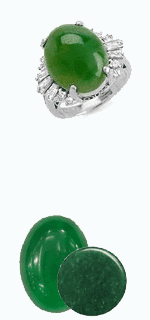| Colors: |
While Nephrite is generally only green, cream, or white, Jadeite colors can range through the color spectrum with more exotic colors. The most valuable form is called Imperial Jade, which is emerald-green in color and translucent. |
| Shapes: |
Jade is most often polished into cabochons and beads, and is used in bracelets, necklaces, rings, and earrings. Ornamental figures,ornate engraved pendants and cameos have traditionally been carved from Jade. |
| Origin: |
Mynamar (Burma); China (Tibet), Russia, Kazakhstan, Guatemala, and the United States. |
| Care: |
To clean jade properly, you can use only water. Alternatively, you can prepare a simple cleaning solution by adding a little mild soap to the water. However, do not use any other jewelry cleaners or household detergents that may contain harsh chemicals. |
| Notes: |
The name Jade is derived from the Spanish phrase "Piedra de Ijada", which means "Stone of the Hip", as this stone was used as a metaphysical protection against kidney disease by the ancient societies. |

